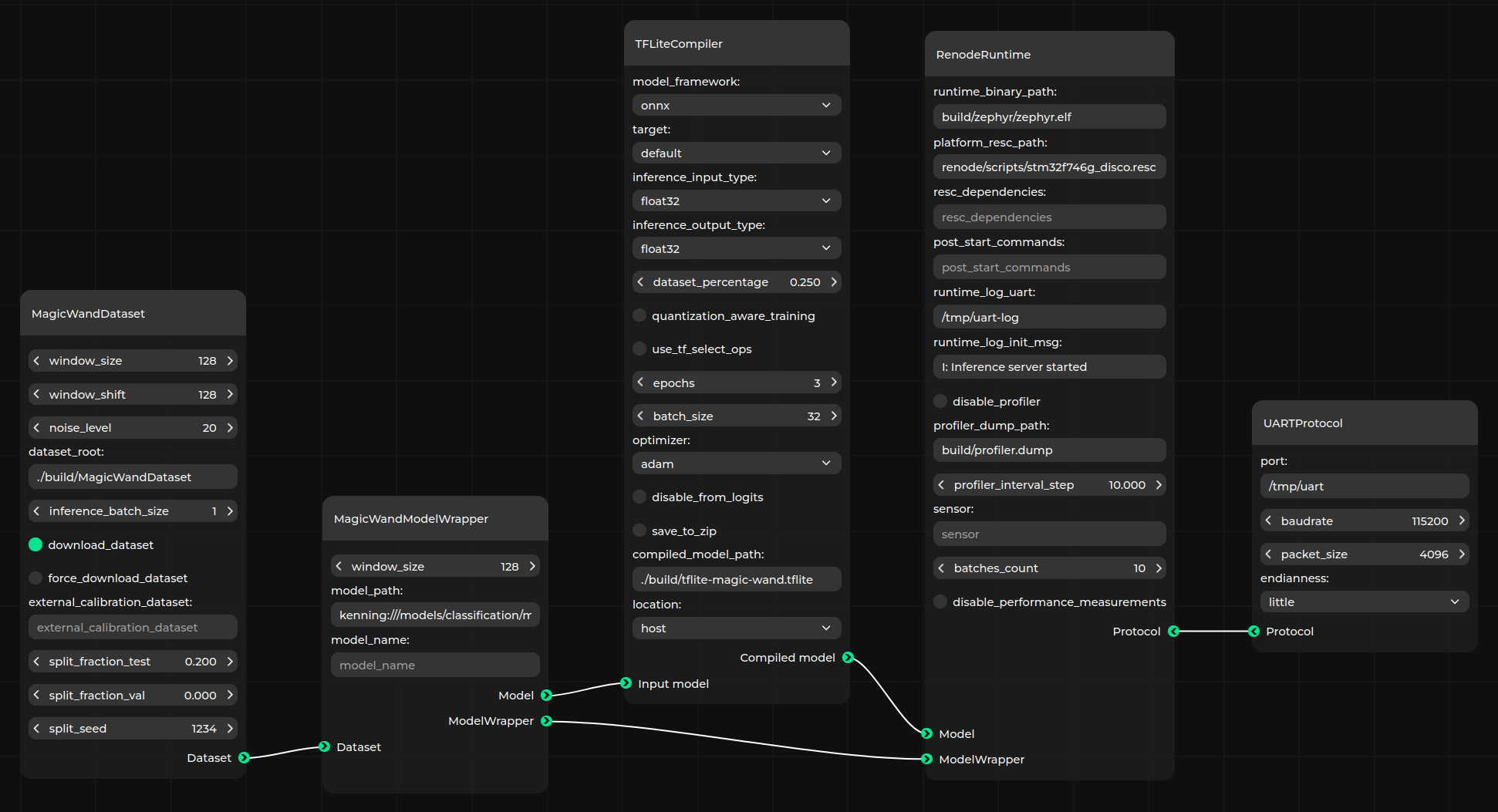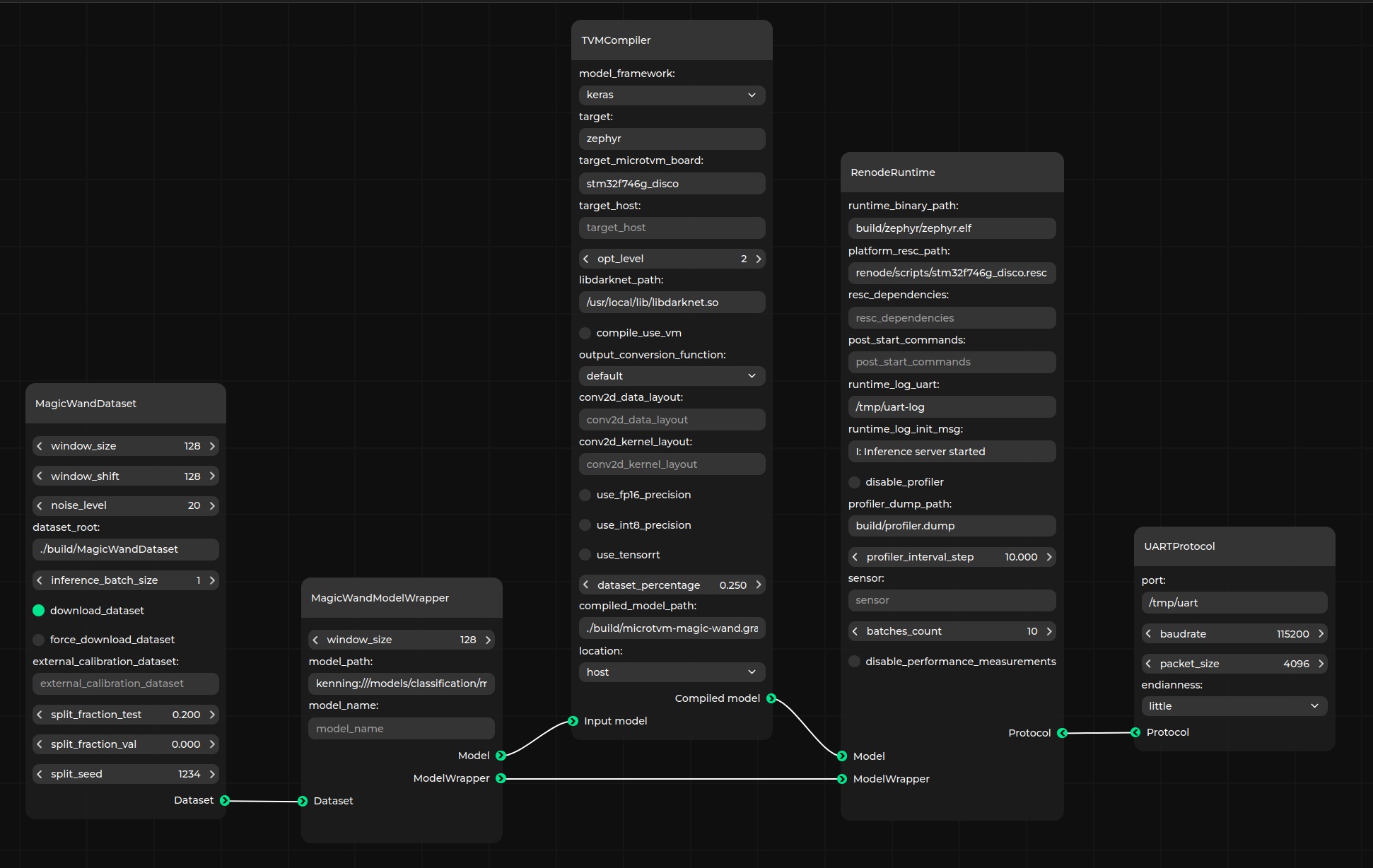Evaluating models on hardware using Kenning Zephyr Runtime¶
This section contains tutorial of evaluating models on microcontrollers using Kenning Zephyr Runtime and Renode.
Preparing the Zephyr environment¶
First, we need to setup environment for building the runtime. Start with installing dependencies:
jqcurlwestCMake
On Debian-based Linux distributions, the above-listed dependencies can be installed as follows:
apt update
apt install -y --no-install-recommends ccache curl device-tree-compiler dfu-util file \
g++-multilib gcc gcc-multilib git jq libmagic1 libsdl2-dev make ninja-build \
python3-dev python3-pip python3-setuptools python3-tk python3-wheel python3-venv \
mono-complete wget xxd xz-utils patch
Next, create a Zephyr workspace directory and clone there Kenning Zephyr Runtime repository:
mkdir -p zephyr-workspace && cd zephyr-workspace
git clone https://github.com/antmicro/kenning-zephyr-runtime.git
cd kenning-zephyr-runtime
Then, initialize Zephyr workspace, ensure that latest Zephyr SDK is installed, and prepare a Python’s virtual environment with:
./scripts/prepare_zephyr_env.sh
source .venv/bin/activate
Finally, prepare additional modules:
./scripts/prepare_modules.sh
Installing Kenning with Renode support¶
Evaluating models using Kenning Zephyr Runtime requires Kenning with Renode support.
Use pip to install it:
pip install --upgrade pip
pip install "kenning[tvm,tensorflow,reports,renode] @ git+https://github.com/antmicro/kenning.git"
To use Renode, either follow Renode documentation or use the script:
source ./scripts/prepare_renode.sh
Building and evaluating Magic Wand model using TFLite backend¶

Let’s build the Kenning Zephyr Runtime with TFLiteMicro as model executor for stm32f746g_disco board.
Run:
west build --board stm32f746g_disco app -- -DEXTRA_CONF_FILE=tflite.conf
west build -t board-repl
The built binary can be found in build/zephyr/zephyr.elf.
To evaluate the Magic Wand model using built runtime, run:
kenning optimize test \
--cfg kenning-scenarios/renode-zephyr-tflite-magic-wand-inference.yml \
--measurements build/zephyr-stm32-tflite-magic-wand.json --verbosity INFO \
--verbosity INFO
The evaluation results would be saved at build/zephyr-stm32-tflite-magic-wand.json.
Building and evaluating Magic Wand model using microTVM backend¶

Building the Kenning Zephyr Runtime with microTVM support for the same board requires changing only -DEXTRA_CONF_FILE value.
Run:
west build --board stm32f746g_disco app -- -DEXTRA_CONF_FILE=tvm.conf
west build -t board-repl
And now, as previously, run evaluation using Kenning:
kenning optimize test \
--cfg kenning-scenarios/renode-zephyr-tvm-magic-wand-inference.yml \
--measurements build/zephyr-stm32-tvm-magic-wand.json --verbosity INFO \
--verbosity INFO
The evaluation results would be saved at zephyr-stm32-tvm-magic-wand.json.
Comparing the results¶
To generate comparison report run:
kenning report \
--measurements \
build/zephyr-stm32-tflite-magic-wand.json \
build/zephyr-stm32-tvm-magic-wand.json \
--report-path build/zephyr-stm32-tflite-tvm-comparison.md \
--report-types renode_stats performance classification \
--to-html
The HTML version of the report should be saved at build/zephyr-stm32-tflite-tvm-comparison/zephyr-stm32-tflite-tvm-comparison.html.